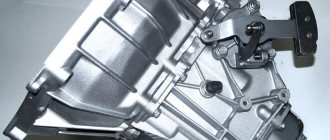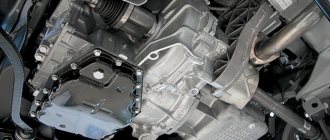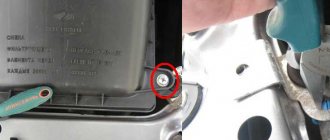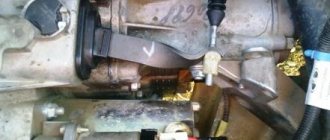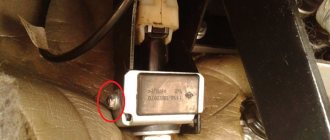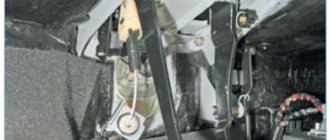VAZ cars use a clutch cable with automatic adjustment. The machine itself is a separate unit, which is fixed near the pedals. Clicking or crackling noises when the machine operates can be considered normal. But if the pedal begins to sink and the clutch does not disengage completely, then the automatic system will no longer help - you need to forcibly reduce the length of the cable. A threaded tip is provided for these purposes. That is, clutch adjustment on the Lada Grant can be done manually. Let's look at all the steps in more detail.
How can the clutch pedal click? Find out in the video.
Device and methods for adjusting the clutch of Lada Grants
The clutch is designed to connect and disconnect the gearbox and engine flywheel, smoothing out sudden changes in torque loads. The friction clutch allows the car to start and stop smoothly with the power unit running. If sudden braking is necessary with the clutch engaged, it slips, protecting the gearbox from possible overloads. In good condition, the mechanism should provide a reliable connection between the transmission and the power unit.
Why the ECM detects error “P0830”, video explanation
Praise to the author! I am also a terrible car enthusiast, albeit with little experience... I also had right-hand drive ones, but unfortunately, they are not convenient with our traffic. I now have probably the most boring Toyota model. For almost 2 years of owning this car, I had no problems at all, it burned out once a light bulb in the foot, and I changed the brakes and oil according to plan, despite the fact that the car is 8 years old, the mileage is about 150 thousand. It accelerates quickly, drives smoothly, and is maneuverable. spacious trunk and for its size a very comfortable and spacious interior, dad feels completely comfortable in the back seat, and he is a large man. After a night in a windswept parking lot at minus 35, it started up and didn’t even sneeze once. The stove heats perfectly, the air conditioner cools quickly, the consumption is 6-7 liters of 92 in the city. engine 1.5. 106 horses, + with its size it will fit into any hole in the parking lot. In short, the car is just great. )))
I've been meaning to adjust the clutch on my Grant for a long time. I made a printout of your article. Tomorrow I’ll arm myself with the necessary tools and go to the garage to do everything with my own hands step by step, as described in the article.
Open the hood, under the air filter there is a clutch foot. It is equipped with a cable with a plastic screw. Lightly pressing the foot, remove the cable to the side. We adjust the cable screw and put it back on the foot.
When accelerating, the engine roars slightly when the leveler revs up
Clutch needs replacement! It's slipping!
When starting off there is jerking, what could be the problem?
Replacement clutch disc
I sharpened the flywheel! and he was crooked. so you can’t get away with just one disk
The clutch cable broke. I went and bought a new one. Changed it. While I was driving, the clutch was soft; accidentally, in 4th gear at 90 km/h, I jumped into 3rd gear instead of 5th. But nothing. An hour later, I noticed that when changing gears, my car seemed to be giving up gas (by the sound), but in fact I don’t know what it is. The clutch pedal has free play, i.e. hanging out. And the pedal is too soft. Can there be different clutch cables on the grant?
The clutch is designed to connect and disconnect the gearbox and engine flywheel, smoothing out sudden changes in torque loads. The friction clutch allows the car to start and stop smoothly with the power unit running. If sudden braking is necessary with the clutch engaged, it slips, protecting the gearbox from possible overloads. In good condition, the mechanism should provide a reliable connection between the transmission and the power unit.
Friction clutch device
The manufacturer installs the same clutch on the Lada Granta as on the Lada Kalina. The mechanism consists of a flywheel with a basket attached to it. The task of the latter is to continuously press the disk with linings made of friction material - this is how the torque from the engine is transmitted to the transmission. A cable-type clutch means that when the pedal is pressed, the cable connected to the clutch fork becomes taut, the paddles stop pressing the disc, and torque from the engine is not transmitted to the gearbox.
The clutch on the Grant has one disc; it is frictional with a central spring in the form of a diaphragm. It is located in a special aluminum crankcase and combined with the gearbox in one housing, attached directly to the cylinder block. For clarity, you can see a detailed drawing of the device.
Lada Granta clutch device
- Drive cable.
- Outer braid of the cable.
- The end of the cable braid is lower.
- Dust cover.
- Metal leash.
- Fork bracket.
- Bearing sleeve.
- Release bearing.
- Casing.
- Diaphragm spring.
- Disk (master).
- Flywheel.
- Friction material linings on the disc.
- Disk (slave).
- Damper spring.
- Rotation vibration damper.
- Disc hub (driven).
- Central spring.
- Cable end.
- Automatic cable tensioner housing.
- Sleeve.
- Fastening the cable braid.
- Pan (crankcase).
- Gearbox input shaft.
On the Lada Grant, the clutch does not require additional adjustment during its entire service life - this is what is written in the car’s operating manual.
Types of knots
The design and operating principle of the most common dry-type clutch design installed on cars with a manual transmission was described above. In passenger cars equipped with automatic transmissions, “wet” type systems are used, where the parts of the friction mechanism are immersed in liquid. This allows you to reduce the impact of friction and extend the life of the unit.
Existing clutch designs are divided into the following types:
- by the number of friction surfaces: single and multi-disc;
- by control method: mechanical, servo-driven and hydraulic;
- according to the working environment - dry and wet.
A multi-disc system was introduced along with high-power motors. The reason is as follows: one group of friction linings is difficult to withstand increased loads and wears out quite quickly. Thanks to the design with two discs separated by a spacer, the high torque is evenly distributed between 2 groups of pads (squeezing occurs simultaneously). Reducing the specific load increases the service life of the unit.
You have already become familiar with the operation of a mechanical (pedal) drive. On cars with an automatic transmission, a torque converter drive is usually installed, which engages the clutch independently. The principle of operation is simple: along with an increase in crankshaft speed, the oil pressure in the transformer increases. When it reaches a certain threshold, a valve is activated, releasing the springs and switching speeds automatically.
The clutch in a car with a robotic gearbox is activated by a servo drive at the command of the electronic control unit. The latter is guided by sensor readings and at the right moment sends a signal to the drive to depress the clutch. The driver can also choose the moment to switch to another speed by sending an impulse through the gearshift knob or steering wheel paddles.
Clutch adjustment methods
All diagnostic and adjustment work is carried out only with the engine turned off. To identify the need to adjust the friction clutch, you should perform a few simple steps. You need to press the pedal two or three times - no knocks, squeaks or other extraneous noises should be heard. The pedal should move freely, without sticking. If you suspect that the pedal is sticking, but visually everything is in order, you should perform the following manipulations:
- press the pedal all the way by hand;
- release the pedal, but do it in such a way that your hand is on it, thereby you can feel its movement, but not interfere with its progress.
You can feel even the slightest jamming or jerking with your hand when the pedal returns to its initial position. If characteristic twitching is observed, it is necessary to make adjustments.
Using a ruler, measure the distance from the floor to the protruding part of the pedal. You need to press it all the way so that it rests on the floor, then release it. The distance is measured again. If the ruler is more than 145 mm, then the pedal free play must be adjusted to normal values.
The pedal's full travel distance should be no more than 146 mm, less is allowed. The cable guide should move relative to the fork lever no more than 27 mm. Normally, the runout of the friction linings of the disc should not exceed 0.5 mm. There must be a distance of at least 0.2 mm between the rivet holding the lining and the lining itself; less is not allowed.
The Lada Granta is equipped with a regular clutch cable, which is no different from the cable installed on previous VAZ models. The only difference is that on modern cars the cable is equipped with an automatic tension adjustment tip. The mechanism is convenient in that as the clutch parts wear and the cable is pulled, it automatically adjusts the tension.
What does a clutch consist of?
In order not to break the clutch, you need to know not only how it works superficially and what its functions are, but also what parts it consists of. The main components include the driven and driven parts, the shutdown mechanism and the pressure system.
The engine rotational torque is transmitted from the flywheel to the drive parts, which in turn transmit torque to the gearbox drive shaft. The frictional moment is provided thanks to a pressure mechanism, which, thanks to the tight coupling of the driven and driven parts, gives the long-awaited result of movement.
Disengaging the clutch is considered important. So one disk, on which springs are located peripherally, is located in a cast-iron crankcase, which in turn is located in the engine block crankcase.
The drive part includes the clutch housing and flywheel, the latter in turn is attached to the crankshaft flywheel using six special bolts. The pressure plate is located in the middle part of the casing. The torque of the pressure plate is transmitted from the flywheel through three protrusions that are located in the disk and enter the casing windows. The driven disk, hub, and drive shaft of the gearbox are the main and mandatory components of the driven part of the clutch.
On both sides of the driven disk there are friction linings made of a copper-asbestos composition (or another metal-asbestos composition), which can withstand unusually high temperatures and are known for their friction properties. The driven disk is connected to the hub with rivets or through springs. These springs are an integral part of the spring-friction damper of rotating vibrations (that is, the damper).
Clutch cable adjustment
Adjusting the clutch of the Lada Granta begins by pulling the tip of the cable in the direction of its movement, taking into account the fact that the spring will create force. You should fix the cable in this position and start measuring from the front edge of the plastic leash to the clutch fork lever. It should be no more than 2.7 cm. Since there is not much space under the hood, you should prepare a piece of wire of the required length (27 mm) in advance and measure the distance with it.
The leash rotates to adjust the tension. After the clutch cable is released, you need to eliminate the gaps between the driver and the fork lever. Next, the friction clutch pedal is depressed several times - this is how the auto-adjustment mechanism takes its working position - the pedal should not be tight or fall through.
Judging by the reviews of Lada Granta owners, this mechanism is far from ideal and makes various extraneous sounds when you press the pedal - it starts to crunch or click. You can try to get rid of them by increasing or decreasing the distance of 27 mm. You need to select the size individually in each specific case.
Possible clutch malfunctions and methods of elimination
Cause of malfunction
Remedies
The clutch slips (when you press the accelerator pedal hard, the engine picks up speed, but the car barely accelerates.)
Lubrication of the flywheel, pressure plate, friction linings of the driven disk
Wash greasy surfaces thoroughly with white spirit or gasoline and dry.
Replace a heavily lubricated clutch disc. Eliminate the cause of the lubrication (oil leakage through the engine or gearbox seals)
Reduce diaphragm spring force
Replace the pressure plate assembly (“basket”)
Severe wear or burnout of the friction linings of the driven disk
Replace driven plate
Damage or irritation
Remove the jam. Replace transmission parts if necessary
Clutch cables (forward gear is difficult to shift, reverse gear is noisy, gearbox is fine)
Incorrect clutch transmission adjustment (full pedal travel is insufficient)
Adjust the block. Replace a deformed clutch fork
Clutch cable blocked
Lubricate the cable with engine oil. If this does not help (the cable wires are torn, the sheath is damaged), replace the cable
Loose rivets o
failure of friction linings, deformation of the driven disk (final eccentricity more than 0.5 mm)
Severe and uneven wear, scoring on the sliding surfaces of the flywheel or pressure plate
Replace flywheel. If the pressure plate surface is damaged, replace the crankcase with the pressure plate assembly (clutch basket)
Bonding the driven disc hub to the gearbox input shaft splines
Clean the grooves from dirt and remove minor damage with a file.
If the splines are significantly worn or damaged, replace the transmission disc and/or input shaft.
Before assembly, apply fresh CV joint-4 lubricant to the grooves
Skewed or warped disc
Replace the crankcase with the pressure plate assembly (clutch basket)
Cretins at the beginning
Clutch cable blocked
Lubricate the cable with engine oil. If this does not help, replace the cable
Bonding the driven disc hub to the gearbox input shaft splines
Clean the grooves from dirt and remove minor damage with a file.
If the splines are significantly worn or damaged, replace the transmission disc and/or input shaft.
Before assembly, apply fresh CV joint-4 lubricant to the grooves
driven disk deformation
Replace driven plate
Weakened friction linings of the driven disk, severe wear or cracks in the seals
Replace driven plate
Loss of elasticity of the elastic plates of the driven disk
Replace driven plate
Significant failure or failure of torsional vibration damper springs, wear of spring windows
Replace driven plate
Scouring on the sliding surfaces of the flywheel or pressure plate
Replace the flywheel or clutch cover with a pressure plate (clutch basket)
Lubrication of the working surfaces of the friction linings of the driven disk
Wash greasy surfaces thoroughly with white spirit or gasoline and dry.
Replace a heavily lubricated clutch disc. Eliminates the causes of oils
Noise, rattling or rattling noise when the clutch is engaged
Significant failure or failure of torsional vibration damper springs, wear of spring windows
Replace driven plate
driven disk deformation
Replace driven plate
Weakened friction linings of the driven disk, severe wear or cracks in the seals
Replace driven plate
Increased noise when disengaging the clutch
Wear, damage or loss of lubrication from the clutch release bearing
Replacing the cable
To change the cable, you need to carry out a number of simple operations:
- in the car interior (under the panel), the nut that secures the cable to the pedal assembly is unscrewed;
- the braid stopper is removed from the pin;
- use pliers to remove the locking bracket;
- the pedal axle is removed;
- the pedal bracket spring is also dismantled;
- use pliers to pull it towards you and remove the tip stop;
- the pedal is released from the cable end;
- the cable sheath seal is removed (in the engine compartment);
- the tip of the cable connected to the plug must be pulled forward towards you and pulled out of the groove;
- dismantle the tip driver;
- remove the guide bushing;
- pull the Lada Granta clutch cable through the hole between the engine compartment and the car interior.
Before installing a new cable, it must be lubricated. To do this, a little machine oil is poured between it and its shell. Install the new cable in the reverse order. It is impossible not to pay attention to the imperfection of the cable tension mechanism. The reason for its squeaking may be:
- plastic bushing on the pedal;
- plastic leash;
- cable (cable and its sheath);
- gearbox input shaft.
Most of the reasons can be eliminated very simply - you need to lubricate the rubbing parts, for example, with lithol. The same applies to the input shaft - creaking occurs due to lack of bearing lubrication. To lubricate it, you need to get to the fork boot and, pulling it back, generously pump graphite lubricant inside.
The clutch of the Lada Grant remains the same as before. Exactly the same single-disk mechanisms were installed on previous models - Priora, first-generation Kalina, VAZ 2110, 2109, 2108. The plant only partially modified the design, providing it with higher quality parts. Additionally, an automatic cable tensioner has appeared, which in itself is an additional source of malfunctions. This is a fairly old development, and during its use no measures have been taken to eliminate the most common problems. On the contrary, engineers complicated the design by adding additional elements. On the other hand, the Lada Granta clutch is inexpensive to maintain, and you can buy all the necessary spare parts in every car store. Any car owner can replace the Lada Granta clutch with his own hands. Availability and simplicity of design remain AvtoVAZ’s priorities, although quality is not in first place.
Source
How to replace a broken clutch cable
Over time, with a high mileage of the car (70-75 thousand km), the cable gradually begins to fail. Since it works in tension, it wears out over time and threatens to break. If it breaks, the machine will stop. The cable can also simply become deformed from loads.
You can understand that the life of the cable is coming to an end by two signs:
- the pedal sticks;
- The pedal goes almost to the floor.
If you notice this behavior, you should replace the cable as soon as possible. It is most convenient to carry out a scheduled replacement along with other consumables - filters, oils, brake fluid - approximately once every 70 thousand kilometers.
For repairs you will need a 8mm wrench, pliers, a ruler and a new cable. To replace the cable, you need to do the following:
- Unscrew the nut securing the cable to the pedal bracket.
- Release the pin from the stop.
- Use pliers to grab the bracket and, pulling it, remove it from the pedal.
- Separate the pedal from the axle and remove the axle itself.
- Using the jaws of the pliers, engage the tip stopper, pull it out and remove it from the pedal.
- Under the hood, remove the cable seal by pulling it in the direction of travel.
- Unhook the end of the cable from the clutch fork, similarly moving it in the direction of travel.
- Put the old cable aside and take a new one.
- Insert the cable through the hole in the front shield, then secure the wear compensation mechanism to the pedal.
- Secure the shell stop to the pin where the pedals are attached.
- Install the seal on the cable.
- Screw in the leash from the lower end of the cable.
- Insert the cable into place and attach it to the clutch fork.
The clutch cable for domestic cars is inexpensive. You can easily replace it in your garage, but if you do not have such skills, then a car service center will quickly and cheaply perform this procedure. The cable itself costs 400 rubles, and the replacement cost is about 500.
Methods for adjusting the clutch on a Lada Grant with a cable box
Gearbox 2181 turned out to be quite good. Engineers have eliminated many of the shortcomings of the previous model. Repairing a gearbox on a Lada Granta is expectedly cheaper than on other cars. Despite the fact that the shortcomings were eliminated in subsequent cars, car enthusiasts had an unpleasant impression of the new box. Other drivers are pleased with the clarity of gear shifting and the reduction in vibrations.
Many owners complained about the previous model of the Lada Grants gearbox, and engineers decided to modernize it. But not everything went so smoothly - problems emerged. Let's look at how to adjust the clutch on a Grant with a cable box.
Features of a cable gearbox on the Lada Granta
If you compare the 2180 and 2181 gearboxes, they are very different. In the old box, the driver made a lot of effort to shift, especially on previous generation cars. This was due to the fact that the previous manual transmission was based on rigid rods. A strong vibration emanated from them, transmitted into the cabin from the gearbox.
The transition to cables eliminated a number of design flaws. The gearbox now has a short stroke, making gear shifts faster. The gearbox itself consists of cables, a translator, a switching mechanism, jet thrust and a drive control device. The clutch disc has a larger diameter (215 versus 200 mm).
- The volume of oil poured into the box has been reduced (to 2.2 l).
- Different synchronizers were installed in first and second gear, making shifts quite easy.
- Due to the cables, vibrations and noise have been reduced. The switching itself is now clearer and without extraneous sounds. The gearbox gate on the Granta has also become quieter.
- The gearbox has become better behaved in winter conditions.
Preparation for repair
To remove and subsequently replace the clutch, prepare a set of tools consisting of:
- center punch;
- extension cord;
- funnels;
- heads (8, 10, 15, 17, 19 and 30 mm);
- high head (13 mm);
- heads Torx E12 and Torx E14;
- Phillips and flat screwdrivers;
- pliers;
- curved spanners (8 and 13 mm);
- straight spanners (17 and 19 mm);
- two adjustable stops;
- metal brush;
- ratchet wrench;
- caliper;
- stands;
- hammer;
- jack;
- balloon wrench;
- torque wrench;
- centering mandrel.
When clutch adjustment is required: main signs
On average, car manufacturers recommend adjusting the clutch after a mileage of 10 thousand km.
If you observe something from this list, it means you need to make adjustments:
- Extraneous sounds, knocks when shifting into gear.
- Vibrations, if there were none before.
- Change in pedal travel, sinking or heavy movement.
- The car jerks when you start driving.
You will also have to interfere with the operation of the clutch if it is being replaced or repaired. Especially when the pedal falls out or is too hard. If the clutch is not adjusted, it may break.
Are problems with gearbox operation always associated with an unadjusted clutch?
Mechanical transmission problems do not always indicate a clutch that needs to be adjusted. If the clutch seems to be at fault, check the list above. We will also look at other problems with the manual transmission. Frequent malfunctions are:
- Gearbox noise. In neutral, this happens when the oil in the box is reduced or contaminated or the bearings wear out. In transmission, the problem may be in the synchronizer, licked teeth and dead bearings. When changing gears, the problem may be an unadjusted clutch, bearings, synchronizer, misalignment of the clutch housing and crankshaft, as well as deformed clutch forks and gearbox.
- Vibrations. Typical for internal combustion engines with disrupted operation in neutral or when fastenings are destroyed (including self-unscrewing of bolts).
- Leaking oil. The reason is most often in oil seals, gaskets, excess oil level or deformation of the transmission itself.
- The gear shifts with difficulty or does not shift at all. The problem here can also be in the clutch, as well as in other factors - contamination, lack of oil, wear of couplings, springs, gears.
- The transmission turns off by itself. There are many reasons - synchronizers, grooves, springs, spontaneous loosening of bolts and others.
If you suspect clutching, take a closer look at the problem. It is far from certain that it is exactly to blame.
How long a gearbox will last depends directly on how you use the car. And the comfort, safety and controllability of your car depend on the service life of the gearbox.
If you do not want to repair the Lada Granta gearbox, follow a number of simple recommendations:
- With a manual transmission, one of the main operating factors is shifting gears with the clutch pedal fully depressed. You cannot change gears when it is not completely turned off. This leads to accelerated licking of the gear teeth. You need to choose a gear that matches your speed. It is best to move in fourth gear - it is direct and uses a minimum of gears. Accordingly, their wear is reduced. Speed range – 70-100 km/h.
- In winter, you should not leave the car in gear for a long time. This is unsafe and damages the transmission. After you start the engine, even if the car is in neutral, it may jerk.
- Lubrication of all components also has an effect. Periodically check the gearbox housing for oil leaks. They usually appear near the oil filler neck. Change your oil on time. The approximate replacement period is 50-70 thousand kilometers. Do not mix oils of different brands, as this may cause increased wear of all rubbing parts.
Common faults
Most often, the following problems occur in the clutch mechanism:
- leakage of the hydraulic cylinder cuff;
- critical wear of friction linings;
- weakening of the diaphragm spring;
- oiling and slipping of the driven disk;
- breakage or jamming of the plug.
Only the first malfunction associated with a brake fluid leak allows you to easily get to a car service center. In other cases, the clutch may not engage and you will not be able to drive further.
Advice. If you manage to shift the manual transmission into 1st gear, try to move off from the starter without touching the clutch pedal. This will allow you to get to the service station at low speed under your own power.
Sometimes, as a result of a breakdown of the clutch mechanism, the engaged gear “hangs” on the automatic transmission, which makes it possible to get to the garage or workshop. But after stopping, further movement is excluded. If a car with a manual transmission is delivered to the service by towing, then with an automatic transmission only by tow truck.
In this article we will try to reveal the main principles of operation of a car clutch, its components and what their types are.
A sharp start from a standstill, or a heavy load when driving quickly removes the clutch from working condition; the first sign of a clutch failure is poor gearbox shifting, slipping after the gear has been engaged, the gas has been pressed, the engine speed has risen, but the car does not pick up speed. All this leads to one thing, it's time to change the clutch. But still, replacing is not a problem, but in order to prevent such a disaster from happening again, let’s consider the principle of operation of the clutch.
How to adjust the clutch on a Grant with a cable box
On a Lada Granta car, adjusting the gearbox cables is simple. To do this you will need a set of tools:
- pliers;
- ruler;
- lubricant (silicone will do).
How to adjust the clutch on a Grant with a cable box:
- Open the hood and find the cable itself. On the Grant it is next to the left headlight.
- Measure the distance from the plastic retainer to the fork. Normal distance is 27 mm. If there is a discrepancy in the sizes, you need to rotate the lock to reduce them.
- When you release the cable, there should be no gap between the clamp and the fork. Press the pedal three times. The cable adjustment should take place on its own. After this, measure the distance of the pedal's full travel. The maximum value is 146 mm and must not be exceeded.
- Check how the pedal works. There should be no unnecessary noise, and it should be easy to press.
- Start the engine and go for a break-in. There should be no jerks when switching or slipping when starting. Gear shifting should occur without any extraneous sounds. The switching itself should be clear.
Congratulations, the gearbox cable adjustment on your Lada Granta has been successfully completed.
Is the clutch adjustment different on a cable and cableless gearbox?
In recent years, manufacturers have installed only two types of clutches on cars. This is a hydraulic and mechanical drive.
The hydraulic drive is similar in design to the drive of another hydraulic system in a car - the brake drive. The operating principle is based on incompressible fluid. The clutch pedal is connected to the cylinder by a pipeline with brake fluid. This design is more complex and expensive. In addition to the pedal, the system also includes a fluid reservoir and hoses for fluid circulation. A similar drive is used on classics, as well as on new Vesta and X-Ray.
When the driver depresses the clutch pedal, the piston in the master cylinder moves due to the action of the pushrod. Liquid comes from the tank, which goes into the system to the working cylinder, moving the piston. The piston pusher presses on the clutch fork.
Mechanical drive has also been used for quite some time. It has a low price and reliability of the entire structure. In this case, a cable runs from the pedal to the clutch fork through the interior and engine compartment. What unites this all is a lever system and a mechanism for adjusting the pedal stroke. It is he who is on the Lada Granta.
Although both types of clutch are common, the way they are adjusted is very different. The hydraulic is self-adjusting. However, adjustment is possible provided that there is a thread and nut on the slave cylinder. To make adjustments, you will need pliers and a ruler. This is how the setup process works:
- Check the clutch fluid level. It should not be more or less than the norm.
- Find an opportunity to do work under the car. We need a pit, an overpass, a lift. The car must be securely secured.
- Locate the slave cylinder pusher.
- Unhook the spring from the fork. Measure the distance from the fork to the push rod. Then pull out the plug and measure again. Check the dimensions with the documentation. Usually it is 5 mm. If the dimensions do not match, make adjustments.
- Disconnect the spring from the fork, loosen the fixing nut and start turning the adjusting nut. This way the correct dimensions are set.
You definitely need to take the car out for a break-in and check the operation of the clutch and gearbox.
New developments
Nissan plans to completely eliminate mechanics between the steering wheel and wheels; it will be replaced by electronics. This system is called “steer-by-wire”.
European designers are working on creating dual-mass flywheels with a pendulum system. Here 3-4 details that self-define in space should be added. By moving in antiphase, they should dampen vibrations more effectively. There are several options for placing such parts: inside or outside the flywheel, as well as on the basket body. The Germans have already released the first samples with this type of clutch.
What will happen to the car if you don't adjust the clutch?
If you do not adjust the clutch on the Grant with a cable box in a timely manner, the following problems may arise:
- Clutch slipping. A similar malfunction occurs due to the lack of free play in the pedal. The transmission of torque from the flywheel and crankshaft to the gearbox and drive axle will be incomplete. The car may not move or drive slowly with the pedal fully lowered. There may be a burning smell.
- Late response to the pedal. Triggering can be either early or late. When early, the car starts moving as soon as the pedal begins to be released (there is no free play). When it’s late, the car starts moving when the pedal is almost completely released.
- The clutch does not disengage completely, the friction disc does not separate from the flywheel. The gears will shift with force, and the sound of synchronizer teeth hitting the gearbox gears will sound. Gears may lose teeth.
Gearbox 2181 turned out to be quite good. Engineers have eliminated many of the shortcomings of the previous model. Repairing a gearbox on a Lada Granta is expectedly cheaper than on other cars. Despite the fact that the shortcomings were eliminated in subsequent cars, car enthusiasts had an unpleasant impression of the new box. Other drivers are pleased with the clarity of gear shifting and the reduction in vibrations.
Source
| The clutch drives (switching gears is difficult) | |
| Not enough pedal travel | Adjust cable tension |
| Damage (curvature) of the driven disk | Replace driven disk |
| The clutch disc hub is stuck on the input shaft | Clean the splines; if there is severe wear, replace the input shaft and driven disk |
| Curvature of the pressure plate | Replacing the basket pressure plate |
| Damage to the friction linings of the driven disk | Replace the disc and check for axial runout |
| Malfunction of the cable tension mechanism | Replace the cable |
| Clutch slipping (the car does not move when the speed increases and the gear is engaged) | |
| Burning or partial (complete) wear of the friction linings | Replace disk |
| Oily friction linings | Clean the linings, replace worn parts, eliminate the cause of oil leakage |
| Drive jammed | Replace faulty elements |
| Sharp jerks when shifting gears | |
| Disc linings are oily | Clean the linings, replace worn parts, eliminate the cause of oil leakage |
| Drive jammed | Replace worn parts |
| Bent or damaged pressure plate | Replacing the basket |
| Extraneous sounds when turning on speed | |
| Worn or damaged disc damper springs | Replacing the drive |
| Whistle when turning on speed | |
| Worn or damaged release bearing | Part replacement |
What is the function of the clutch?
Imagine that after engaging 1st gear, the input shaft of the box is connected directly to the running engine. Hypothetical scenarios for the development of events look like this:
- the motor will not have enough effort to cope with the applied full load, as a result of which it will stall;
- the power unit will have enough power to overcome the load, which will result in a strong jerk of the car forward;
- If at this moment you increase the speed by pressing the gas pedal, then the torque of the crankshaft can break the teeth of the gearbox gears.
As you can see, among the listed options there is no smooth movement from a standstill, which occurs on cars in real life. The reason is as follows: without a clutch it is impossible to move off normally. Moreover, you won’t even turn on the first speed - direct joining of two shafts will give the above-mentioned jerk. Shifting to higher gears is also excluded.
Hence the conclusion: a clutch built between the input shaft of the gearbox and the engine crankshaft is needed to smoothly connect one unit to another. Thanks to it, the torque is transferred to the transmission not immediately, but gradually.
When you release the pedal on the far left and move away, you feel an increasing force and, if necessary, you can add gas so that the car does not stall. The transition to 2nd and subsequent speeds is made in the same way. In cars with an automatic transmission (automatic transmission) there is no clutch pedal, since the intermediary unit operates without the participation of the driver - shifting is performed by a hydraulic or electric drive.
